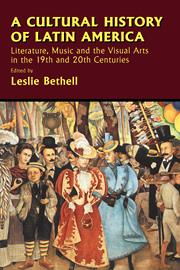 A Cultural History of Latin America
A Cultural History of Latin America 2 - Literature, music and the visual arts, 1870–1930
Published online by Cambridge University Press: 05 June 2012
Summary
INTRODUCTION
By the time the great romantic writer Domingo Faustino Sarmiento (1811–88) became president of Argentina in 1868 irresistible changes were sweeping over Latin America which were reflected in each of the arts, though above all in literature. Most works produced at that time still seem romantic to modern eyes, but perceptible differences were emerging, how much or how soon depending largely on the city or region in which they originated. Some of the changes arose from purely internal factors, but the period around 1870 also saw the beginning of the intensification of the international division of labour and the more complete integration of the Latin American economies, including many regions of the interior, into the world economic system. The population of Latin America doubled during the second half of the nineteenth century, and the process of urbanization quickened: by 1900 Buenos Aires had one million inhabitants, Rio de Janeiro three-quarters of a million, Mexico City more than half a million, and a number of other cities, including São Paulo – which in 1850 had only 15,000 – were over a quarter of a million in size. By 1930 in some of the fastest growing cities 30 to 50 per cent of the population were European immigrants, mostly Italian and Spanish, or children of European immigrants. If the period 1830–70 had been mainly one of introspection and internal frustration, particularly in Spanish America, the period from 1870–1914 saw the continent looking outwards again, though an extra dimension of disillusionment, for peoples already sobered by decades of internal strife, was added when Latin American nations began to wage large-scale wars on one another.
- Type
- Chapter
- Information
- A Cultural History of Latin AmericaLiterature, Music and the Visual Arts in the 19th and 20th Centuries, pp. 47 - 130Publisher: Cambridge University PressPrint publication year: 1998
- 9
- Cited by


